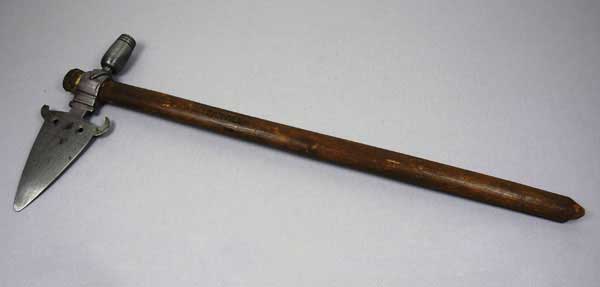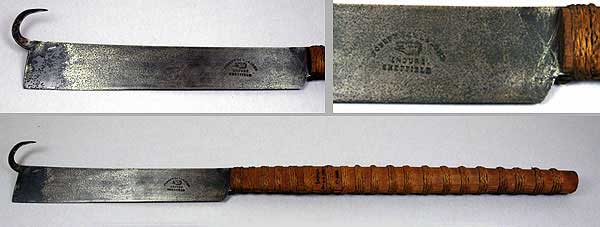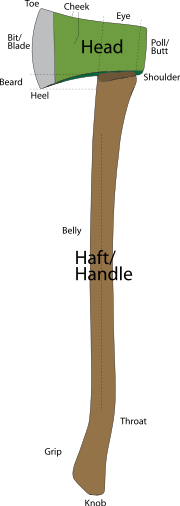Axe
In Amtgard
Axes can be made to fit into many of the currently used weapon categories; Great, Long, Short, even throwing weapons.
Axes in history
The axe, or ax, is an implement that has been used for millennia to shape, split and cut wood, harvest timber, as a weapon and a ceremonial or heraldic symbol. The axe has many forms and specialized uses but generally consists of an axe head with a handle, or helve.

The earliest examples of axes have heads of stone with some form of wooden handle attached (hafted) in a method to suit the available materials and use. Axes made of copper, bronze, iron, steel appeared as these technologies developed. The axe is an example of a simple machine, as it is a type of wedge, or dual inclined plane. This reduces the effort needed by the wood chopper. It splits the wood into two parts by the pressure concentration at the blade. The handle of the axe also acts as a lever allowing the user to increase the force at the cutting edge (try using an axe head without a handle and you will see what is meant) - not using the full length of the handle is known as choking the axe. For fine chopping using a side axe this sometimes is a positive effect, but for felling with a double bitted axe it reduces efficiency.

Generally cutting axes have a shallow wedge angle, whereas splitting axes have a deeper angle. Most axes are double beveled, i.e. symmetrical about the axis of the blade, but some specialist broadaxes have a single bevel blade, and usually an offset handle that allows them to be used for finishing work without putting the user's knuckles at risk of injury. Less common today they were once an integral part of a joiner and carpenter's tool kit - not just a tool for use in forestry. A tool of similar origin is the billhook with short handle and long blade it can be used for tasks where an axe is unsuitable. However in France and Holland the billhook often replaced the axe as a joiner's bench tool.
Most modern axes have steel heads and wooden handles, typically hickory in the USA and ash in the UK and Europe, although plastic or fiberglass handles are also common. Modern axes are specialized by use, size and form. Hafted axes with short handles designed for use with one hand are often called hand axes but the term hand axe refers to axes without handles as well. Hatchets tend to be small hafted axes often with a hammer on the back side ( the poll).
Axes were frequently used in combat as they were easy to make, and the village edge tool makers were frequently the armourers to the lord of the manor in times of war.
Initially axes were probably not hafted. The first true hafted axes are known from the Mesolithic period (ca. 6000 BC). Axes made from ground stone are known since the Neolithic. Few wooden hafts have been found from this period, but it seems that the axe was normally hafted by wedging. Birch-tar and raw-hide lashings were used to fix the blade.
Sometimes a short section of deer antler (an "antler sleeve") was used, which prevented the splitting of the haft and softened the impact on the stone blade itself, helping absorb the impact of each axe blow and lessening the chances of breaking the handle. The antler was hollowed out at one end to create a socket for the axehead. The antler sheath was then either perforated and a handle inserted into it or set in a hole made in the handle instead.
At least since the late Neolithic, elaborate axes (battle-axes, T-axes, etc.) had a religious significance and probably indicated the exalted status of their owner. Certain types almost never show traces of wear; deposits of unshafted axe blades from the middle Neolithic (such as at the Somerset Levels in Britain) may have been gifts to the deities.
In Minoan Crete, the double axe (labrys) had a special significance, used by women priests in religious ceremonies. In 1998 a labrys, complete with an elaborately embellished haft, was found at Cham-Eslen, Canton of Zug, Switzerland. The haft was 120 cm long and wrapped in ornamented birch-bark. The axe blade is 17,4 cm long and made of antigorite, mined in the Gotthard-area. The haft goes through a biconical drilled hole and is fastened by wedges of antler and by birch-tar. It belongs to the early Cortaillod culture. In the Roman fasces, the axe symbolized the authority to execute and were often used as symbols for Fascist Italy under Mussolini. In folklore, stone axes were sometimes believed to be thunderbolts and were used to guard buildings against lightning, as it was believed (mythically) that lightning never struck the same place twice. This has caused some skewing of axe distributions.
Steel axes were important in superstition as well. A thrown axe could keep off a hailstorm, sometimes an axe was placed in the crops, with the cutting edge to the skies to protect the harvest against bad weather. An upright axe buried under the sill of a house would keep off witches, while an axe under the bed would assure male offspring.
